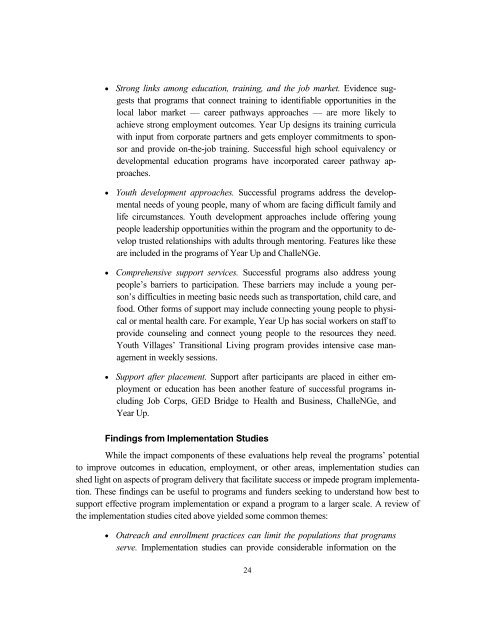Opportunity Youth: Disenfranchised Young People
Opportunity Youth: Disenfranchised Young People
Opportunity Youth: Disenfranchised Young People
You also want an ePaper? Increase the reach of your titles
YUMPU automatically turns print PDFs into web optimized ePapers that Google loves.
• Strong links among education, training, and the job market. Evidence suggests<br />
that programs that connect training to identifiable opportunities in the<br />
local labor market — career pathways approaches — are more likely to<br />
achieve strong employment outcomes. Year Up designs its training curricula<br />
with input from corporate partners and gets employer commitments to sponsor<br />
and provide on-the-job training. Successful high school equivalency or<br />
developmental education programs have incorporated career pathway approaches.<br />
• <strong>Youth</strong> development approaches. Successful programs address the developmental<br />
needs of young people, many of whom are facing difficult family and<br />
life circumstances. <strong>Youth</strong> development approaches include offering young<br />
people leadership opportunities within the program and the opportunity to develop<br />
trusted relationships with adults through mentoring. Features like these<br />
are included in the programs of Year Up and ChalleNGe.<br />
• Comprehensive support services. Successful programs also address young<br />
people’s barriers to participation. These barriers may include a young person’s<br />
difficulties in meeting basic needs such as transportation, child care, and<br />
food. Other forms of support may include connecting young people to physical<br />
or mental health care. For example, Year Up has social workers on staff to<br />
provide counseling and connect young people to the resources they need.<br />
<strong>Youth</strong> Villages’ Transitional Living program provides intensive case management<br />
in weekly sessions.<br />
• Support after placement. Support after participants are placed in either employment<br />
or education has been another feature of successful programs including<br />
Job Corps, GED Bridge to Health and Business, ChalleNGe, and<br />
Year Up.<br />
Findings from Implementation Studies<br />
While the impact components of these evaluations help reveal the programs’ potential<br />
to improve outcomes in education, employment, or other areas, implementation studies can<br />
shed light on aspects of program delivery that facilitate success or impede program implementation.<br />
These findings can be useful to programs and funders seeking to understand how best to<br />
support effective program implementation or expand a program to a larger scale. A review of<br />
the implementation studies cited above yielded some common themes:<br />
• Outreach and enrollment practices can limit the populations that programs<br />
serve. Implementation studies can provide considerable information on the<br />
24

















